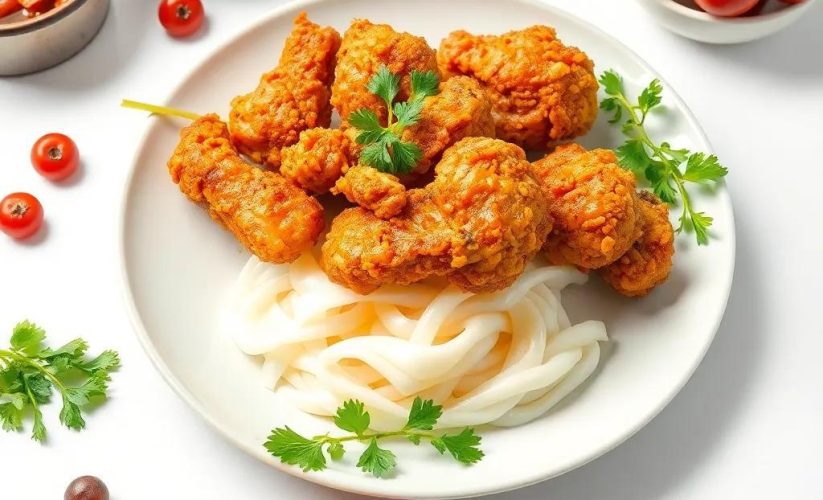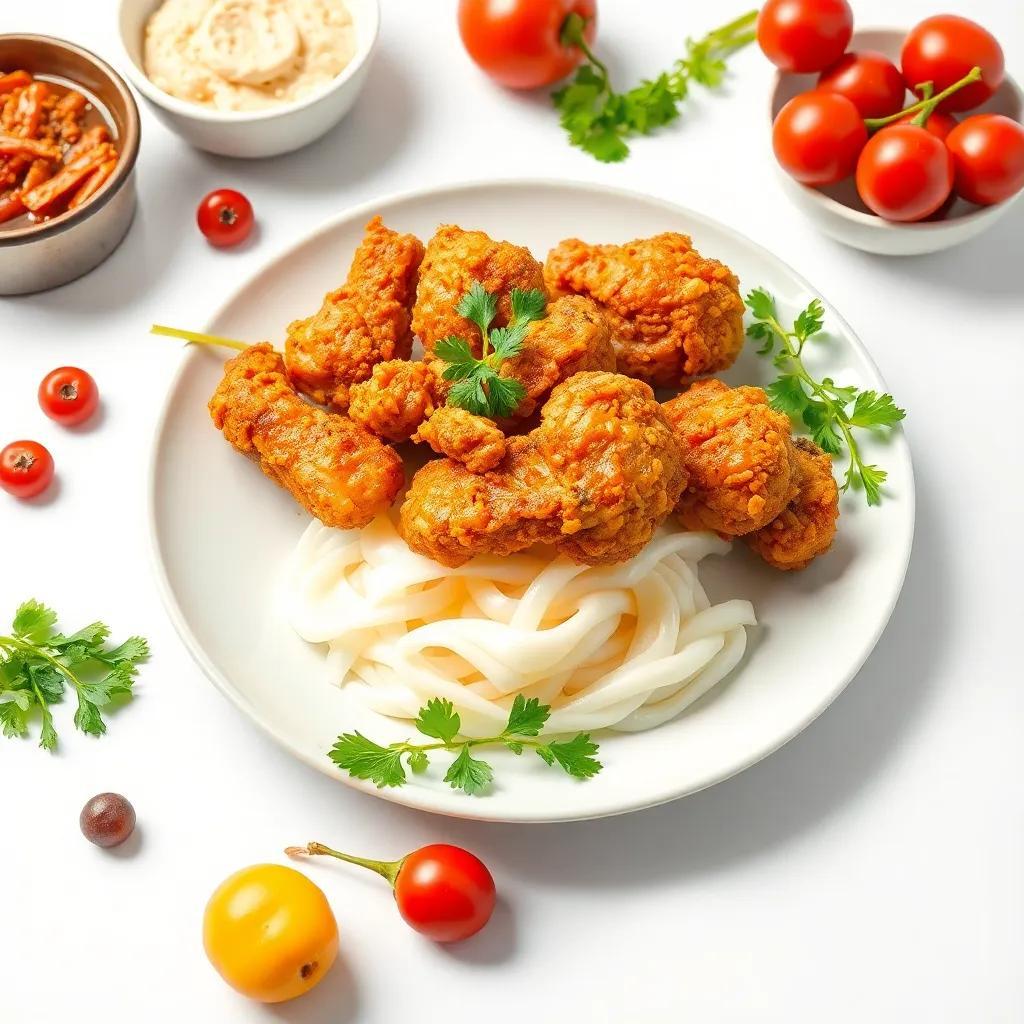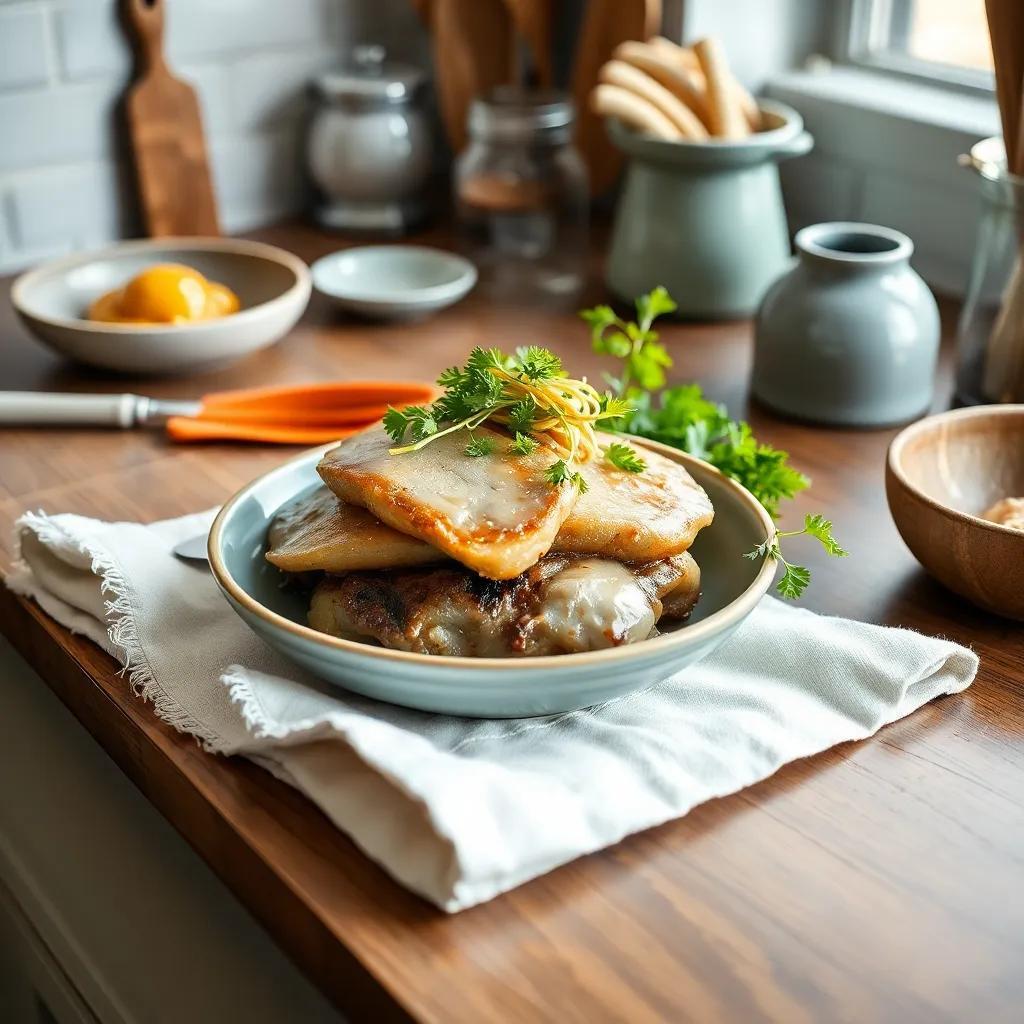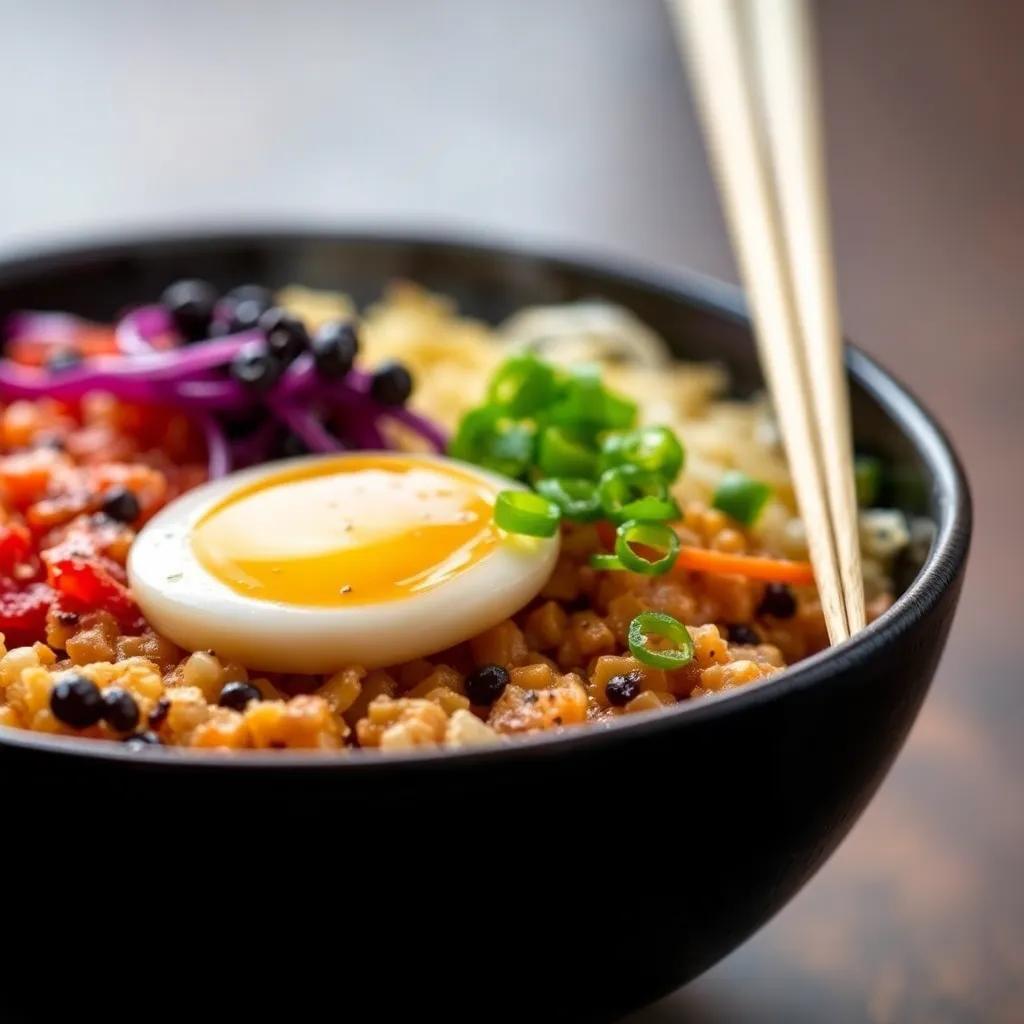Master Easy Gimbap Recipes: Authentic, Kid-Friendly & Vibrant Rolls
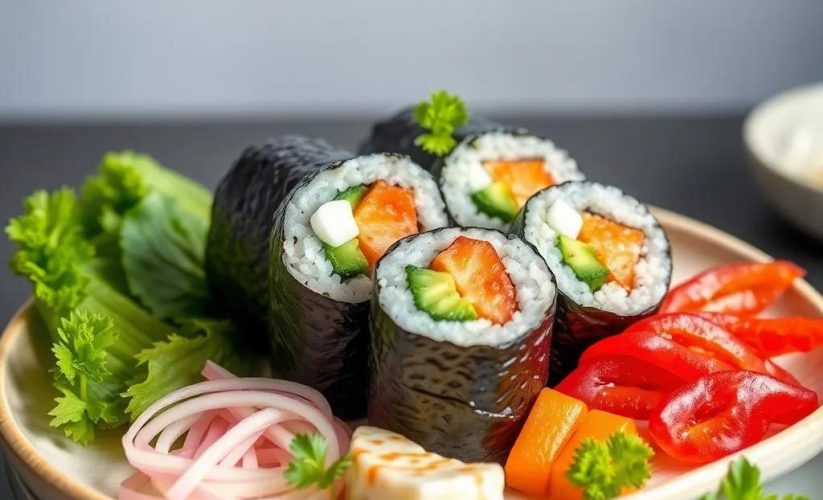
Master Easy Gimbap Recipes: Authentic, Kid-Friendly & Vibrant Rolls
🌍 Cuisine: Korean
⚙️ Difficulty: Easy
Ingredients
Nutrition Facts
210
Instructions
- Cook 2 cups of short-grain rice according to package instructions. Once cooked, let it cool slightly.
- In a small bowl, mix rice vinegar, sesame oil, and salt. Gently fold this mixture into the warm rice, then set aside.
- Prepare vegetables: julienne the carrot and cucumber; blanch the spinach in boiling water for 30 seconds, then drain and squeeze out excess water.
- Season the spinach with a pinch of salt and a few drops of soy sauce. Sauté carrot lightly in vegetable oil with 1/2 tsp sugar until slightly softened. Set both aside.
- Beat the eggs with a pinch of salt and cook into a thin omelette in a lightly oiled pan. Once cooked, slice into long thin strips.
- Gather all fillings: cooked spinach, sautéed carrots, egg strips, cucumber, pickled radish, and imitation crab sticks (optional) for a kid-friendly protein option.
- Place a sheet of nori shiny side down on a bamboo sushi mat. Wet your hands and evenly spread about 1/2 cup of the seasoned rice over the nori, leaving a 1-inch border at the top edge.
- Along the bottom edge of the rice, arrange a layer of each filling: spinach, carrot, egg, cucumber, pickled radish, and crab sticks.
- Using the bamboo mat, carefully roll the gimbap from the bottom edge upward, pressing gently but firmly to form a tight roll.
- Once rolled, lightly brush the roll with sesame oil and sprinkle with toasted sesame seeds for extra flavor.
- Slice the roll into bite-sized pieces (about 1-inch thick) with a sharp knife, wiping the knife clean between cuts for neat slices.
- Serve immediately or pack for lunchboxes. Enjoy the vibrant, kid-friendly authentic Korean gimbap!
Serving Suggestions
- Serve gimbap with a side of kimchi or pickled radish for an authentic accompaniment.
- Pair with a light miso soup or Korean seaweed soup for a more complete meal.
- Present with a dipping sauce made from soy sauce mixed with a bit of sesame oil and chopped green onions.
- Use colorful fillings such as yellow pickled radish and bright spinach for added visual appeal, perfect for kids’ lunchboxes.
- Enjoy chilled or at room temperature for picnics, packed lunches, or casual snacking.
- Garnish with extra toasted sesame seeds or a drizzle of sriracha mayo for a spicy twist.
- Add fresh fruit slices like orange or apple on the side for a balanced and refreshing meal.
Table of Contents
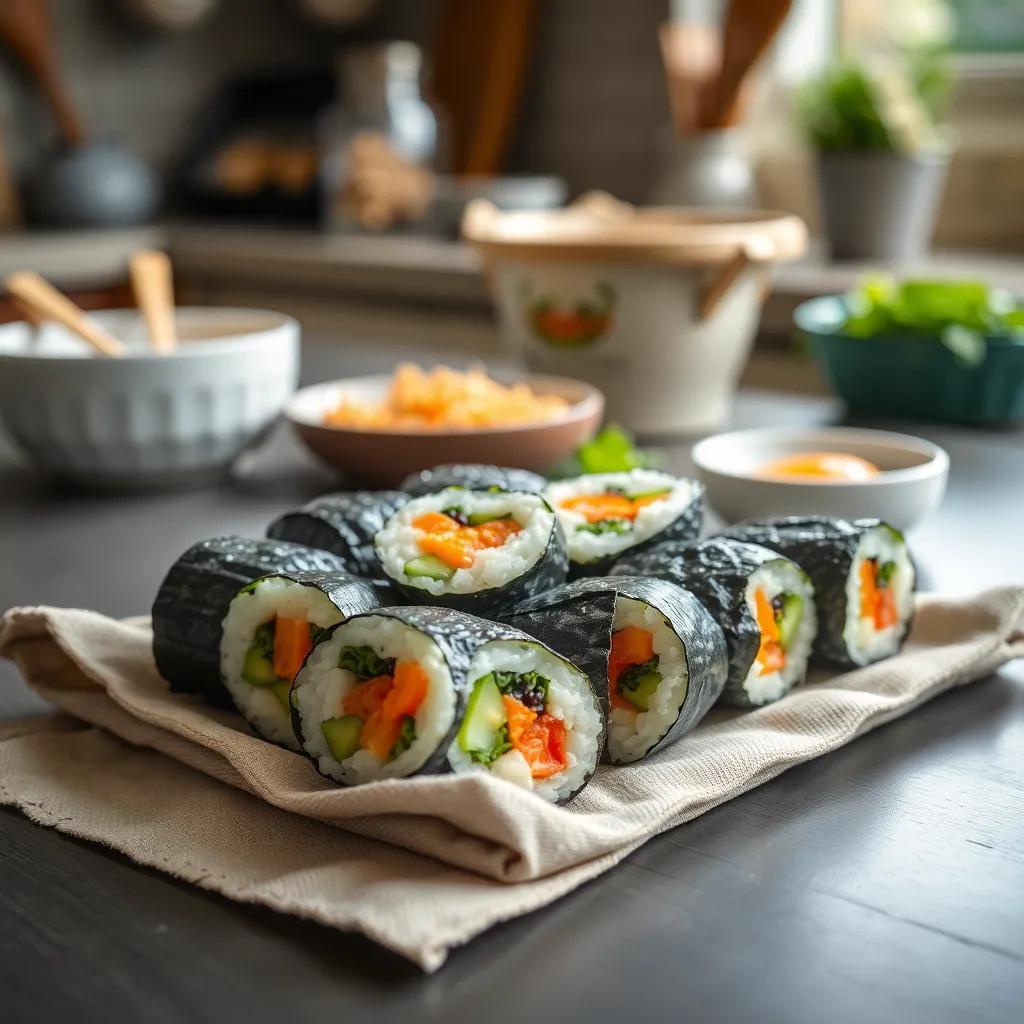
Intro
Gimbap is a delightful Korean snack that brings together simplicity, color, and irresistible flavor in every bite. Whether you’re new to Korean cuisine or looking for a fresh, kid-friendly lunch option, these easy-to-master gimbap rolls offer a wonderful duction to a beloved tradition. What makes these rolls truly special is how effortlessly they transform everyday ingredients into vibrant, satisfying bites that are as fun to make as they are to enjoy.
Perfect for busy weekdays, picnics, or family gatherings, gimbap shines as a versatile dish that invites creativity without overwhelming your schedule. The rolling technique is simple enough for beginners but offers enough room to experiment with flavors and textures. Plus, assembling these rolls is an engaging activity that kids can even join in on, turning mealtime into a shared experience. The result is a portable, colorful meal that carries the warmth of home cooking alongside the excitement of something a little different.
As you dive into this recipe, you’ll find that gimbap isn’t just about ticking boxes—it’s an exploration of balance, presentation, and joy. Whether served as a wholesome snack, a light meal, or a charming addition to a larger spread, these rolls invite you to savor every layer, every bite, and every moment of making them.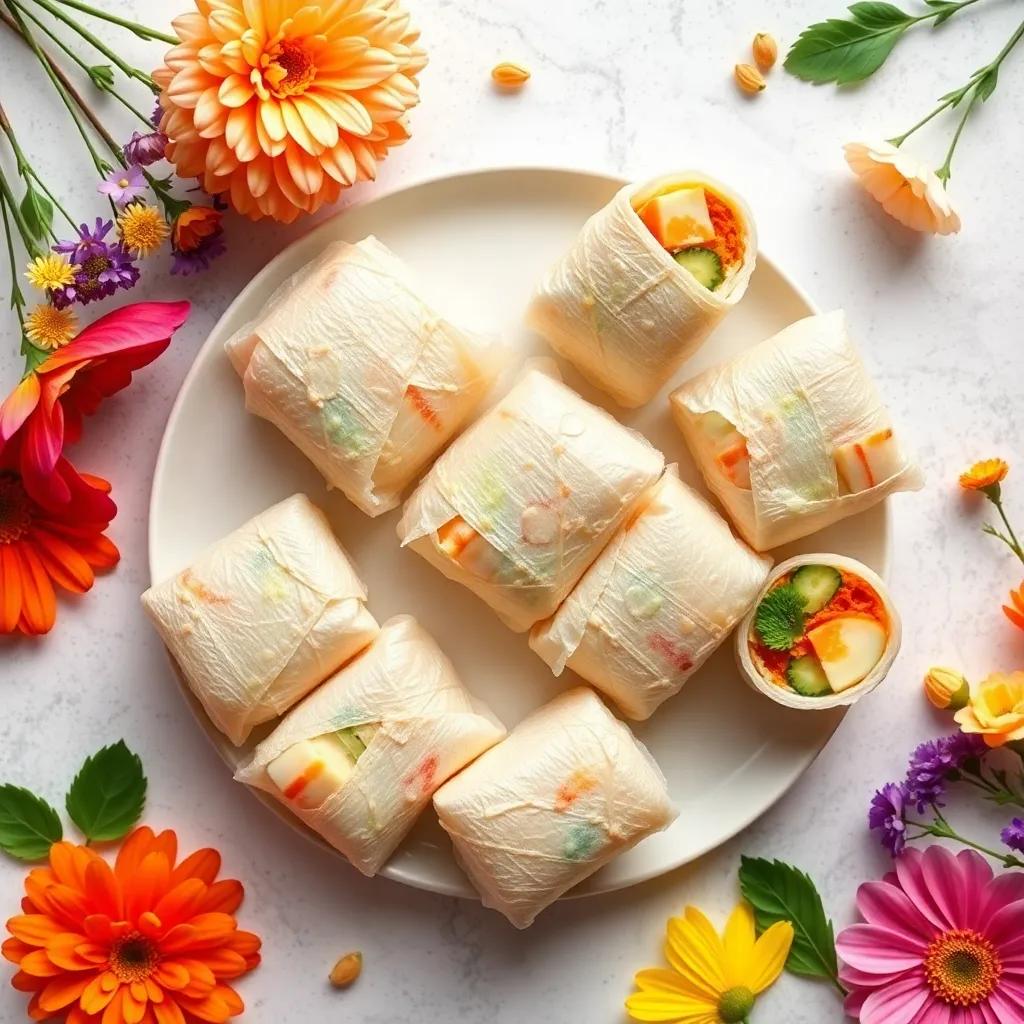
Ingredient Notes
When it comes to crafting the perfect gimbap, a few key ingredients truly elevate the experience and bring authenticity to your rolls. Understanding their role, sourcing tips, and possible substitutions can help you feel confident and creative in the kitchen.
Short-Grain White Rice:
The foundation of gimbap is its rice — ideally, a sticky, slightly chewy short-grain white rice. Its texture helps the rice cling together, making rolling easier and preventing the fillings from slipping out. When shopping, look for sushi rice or Japanese/Korean short-grain varieties—these have the right moisture content. If you don’t have access to short-grain rice, medium-grain rice can work in a pinch, but avoid long-grain rice as it tends to be drier and less sticky. After cooking, seasoning the rice with rice vinegar, salt, and a touch of sesame oil not only enhances flavor but also helps prevent clumping.
Nori (Dried Seaweed Sheets):
Nori sheets are the edible canvas for your gimbap. High-quality nori has a rich, slightly salty umami flavor and a crisp texture that softens once wrapped around the rice. For best results, choose sheets that are dark, uniform in color, and not too brittle. Some stores offer “gimbap-specific” nori, which is thicker and oilier than standard sushi nori, providing a sturdier roll and less likelihood of tearing during rolling and slicing. If nori is unavailable, you could experiment with toasted soy wrappers or thin vegetable leaves like blanched kale for a creative twist, though the flavor will differ.
Yellow Pickled Radish (Danmuji):
The vibrant yellow danmuji is more than just eye candy; it adds a welcomed sweet and tangy crunch that contrasts beautifully with the soft rice and other fillings. Often found in Korean or Asian grocery stores, look for crisp, bright pieces without excessive liquid. If danmuji is not on hand, you can try substituting with mild pickled daikon or even a quickly pickled cucumber strip to maintain that essential sweet-sour bite in your roll.
Toasted Sesame Seeds & Sesame Oil:
Though minor in quantity, toasted sesame seeds and sesame oil deliver a fragrant, nutty richness that rounds out the flavor profile. Sesame oil also gives the rice a subtle sheen and helps keep the grains separate. When buying sesame seeds, opt for pre-toasted versions for the best aroma, or toast raw seeds gently in a dry pan just before use for freshness. For oil, look for 100% pure toasted sesame oil, which is darker and more aromatic compared to light sesame oil. If you need an alternative, a small drizzle of mild olive oil can work, but it won’t fully replicate sesame’s distinctive taste.
Mastering these core ingredients will instantly boost your confidence in making authentic and vibrant gimbap. As you get comfortable, feel free to experiment with ingredient varieties and substitutions to suit your pantry, taste preferences, or dietary needs — after all, gimbap’s beauty lies in its versatility and endless potential for colorful creativity.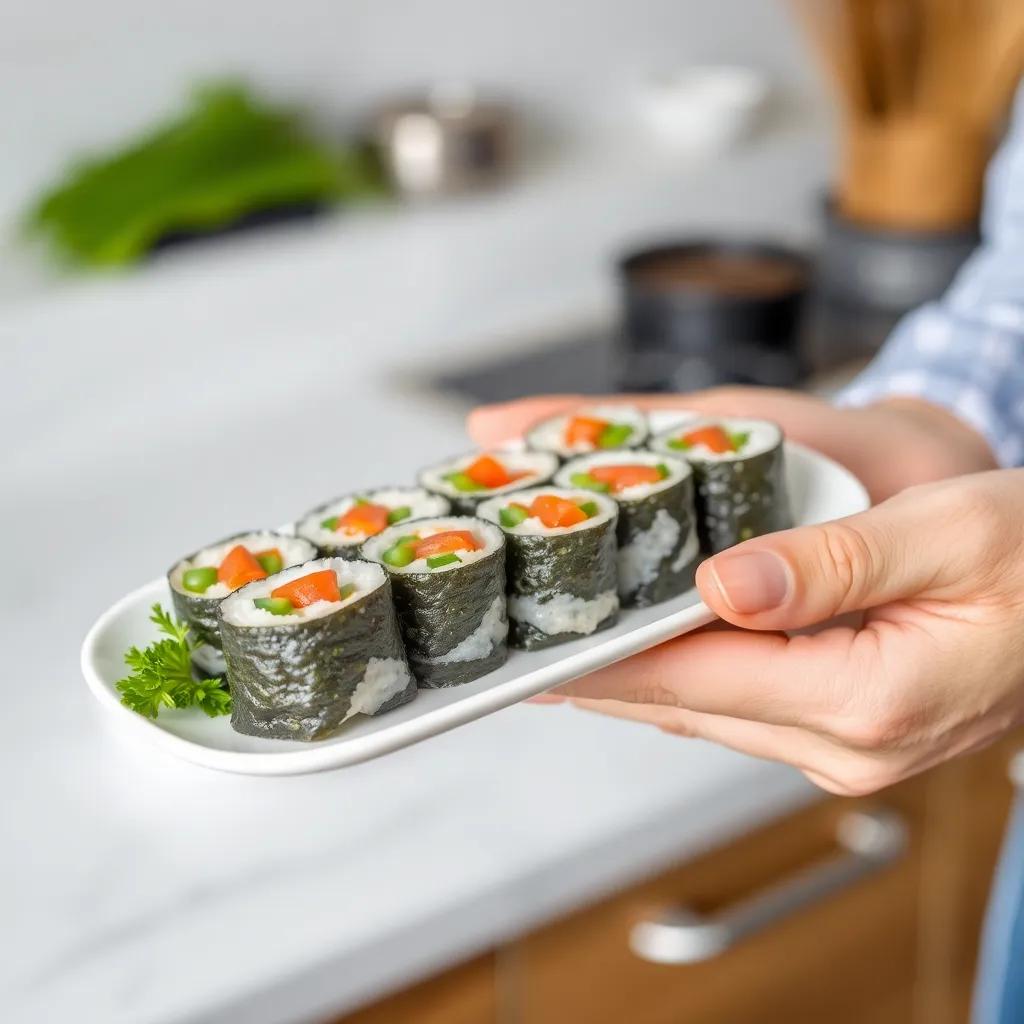
Tips & Variations
To elevate your gimbap-making experience and tailor it to any occasion or dietary preference, consider these expert tips and creative variations:
- Perfect rice texture: Achieving the right stickiness in your rice is key. Slightly warm rice is easier to spread evenly over the nori without tearing it. If your rice feels too dry, lightly mist your hands with water or a little rice vinegar mixture before handling. Avoid overpacking the rice to keep the roll light and easy to bite.
- Rolling finesse: Use a bamboo sushi mat wrapped in plastic wrap to prevent sticking and help roll evenly. Apply gentle but firm pressure when rolling, and don’t be afraid to tighten the roll by squeezing gently after the first wrap. This technique ensures neat slices and prevents the fillings from falling out.
- Kid-friendly adaptations: Since this recipe is aimed at children, feel free to customize the fillings with their favorite veggies or proteins. For a vegan option, swap eggs and imitation crab for marinated tofu strips or seasoned mushrooms. Mild avocado slices or sweet potato cooked until soft add creamy texture and natural sweetness that kids often enjoy.
- Vegetable swaps and seasonal twists: Depending on what’s in season or what you have on hand, experiment with fillings like bell peppers, asparagus tips, or steamed sweet corn kernels. For a refreshing crunch, add thin slices of jicama or radish alongside the classic cucumber.
- Gluten-free tweaks: Make sure to use gluten-free soy sauce or tamari for seasoning the vegetables and avoid any imitation crab containing wheat. Rice and nori are naturally gluten-free, making gimbap a great option for gluten-sensitive eaters.
- Serving style variations: While sliced gimbap is traditional, you can also cut them into fun shapes using small cookie cutters (stars, hearts) to make snack time more playful for kids. Another idea is to serve deconstructed gimbap ingredients as a “build-your-own” roll platter for family gatherings or parties.
- Flavor layering: For those craving a little extra zest, mix a small amount of gochujang (Korean chili paste) or sriracha into the mayonnaise and drizzle it inside the roll or serve it as a side dip. Alternatively, a sprinkle of furikake (Japanese rice seasoning) on the rice can add an umami kick and crunchy texture.
- Enhancing freshness: To keep cucumbers crisp and prevent the rice from becoming soggy, pat any watery veggies dry before assembling. Also, assemble the rolls shortly before serving, or store them wrapped tightly in plastic wrap to maintain moisture balance.
- Playing with textures: Incorporate crunch with toasted nuts like chopped walnuts or roasted pumpkin seeds tucked inside the roll. For softness, add cream cheese or hummus in thin lines to introduce a new mouthfeel and flavor dimension.
These tips and variations open up a world of possibilities around your gimbap, ensuring that each roll can be personalized to your taste, occasion, or dietary needs without losing its authentic charm. Experiment freely—the beauty of gimbap lies in its colorful adaptability!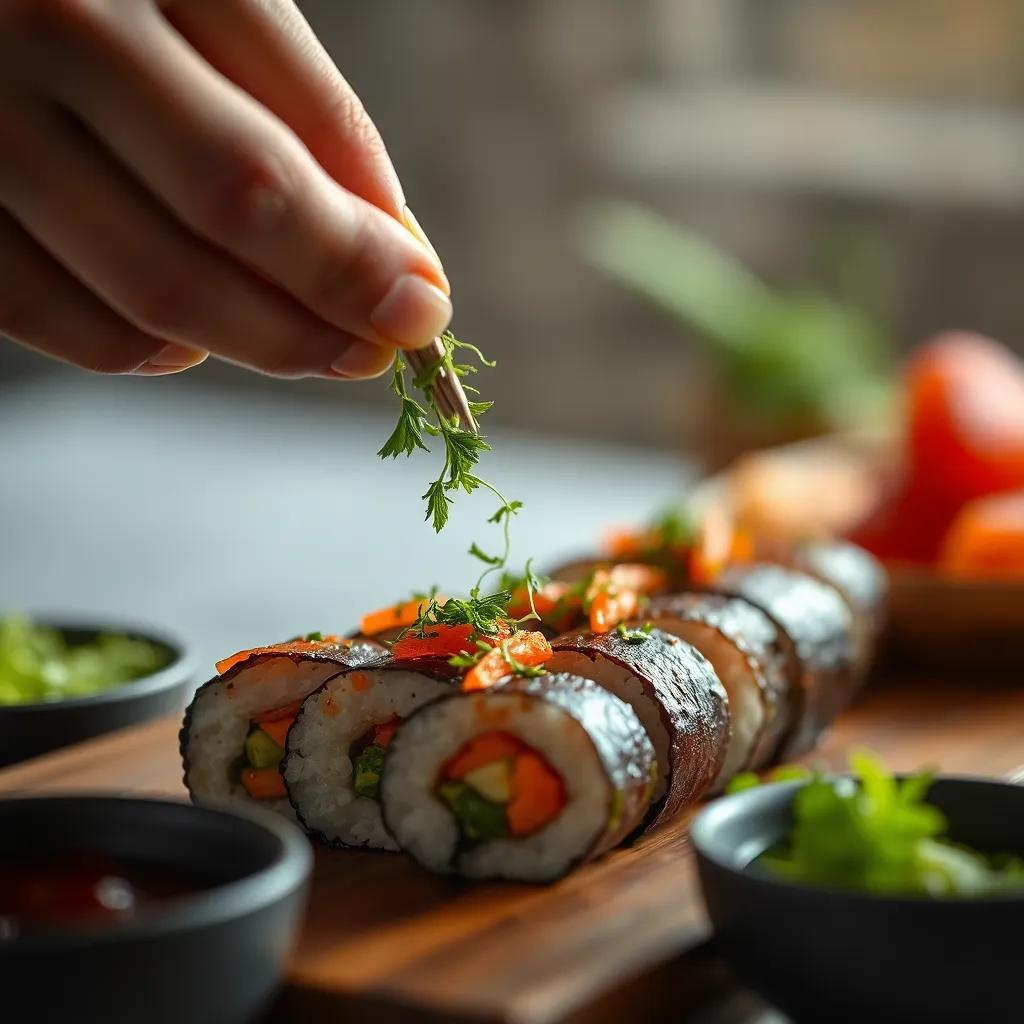
Leftovers & Storage
When it comes to savoring your vibrant gimbap beyond the initial serving, proper storage ensures every bite stays fresh, flavorful, and safe to enjoy later on. Because gimbap ingredients—especially the seasoned rice, fresh vegetables, and cooked eggs—are delicate, mindful handling of leftovers is key to preserving their delightful texture and taste.
To store leftover gimbap, first wrap each roll tightly in plastic wrap or beeswax wrap to lock in moisture and protect the seaweed from drying out or becoming soggy. Placing the wrapped rolls in an airtight container adds an extra layer of defense against fridge odors and helps maintain optimum freshness. Refrigerate promptly and consume within 24 hours for the best quality. While gimbap can be kept up to 2 days in the fridge, the rice tends to harden and the nori can lose its crispness, making it less enjoyable over time.
If you plan to pack gimbap for lunches or picnics, keeping the roll chilled in an insulated lunch box with an ice pack will help maintain its texture until mealtime. Avoid storing cut gimbap pieces loosely exposed, as this accelerates moisture loss and potential drying.
Freezing gimbap is generally not recommended due to the change in texture that occurs with rice and veggies when thawed—rice can become mushy and fillings watery, compromising the roll’s integrity. However, if necessary, wrap each roll very tightly in plastic wrap followed by aluminum foil and freeze for up to one month. Thaw slowly in the refrigerator and consume immediately after thawing. Expect some texture differences, so freezing may be best reserved for cooked fillings rather than fresh crisp vegetables.
For meal prepping, consider assembling all components separately—cooked rice, seasoned vegetables, egg strips, and pickled radish—and then rolling just before serving. This approach guarantees the freshest bite every time and prevents sogginess that happens when rolls sit for hours. If you must prepare rolls ahead, rolling tightly and storing as described above can still work well for short periods.
In summary:
- Wrap tightly in plastic wrap immediately after slicing to keep seaweed crisp and rice moist.
- Store in an airtight container in the refrigerator and consume within 24 hours for best results.
- Keep chilled when transporting to avoid texture loss.
- Freeze only if necessary, wrapped extensively—up to 1 month—with texture expected to change.
- Consider pre-chopping and seasoning ingredients separately for flexible meal prep and last-minute rolling.
With these storage tips, your authentic, colorful gimbap can be enjoyed safely over multiple occasions without losing the charm that makes it such a beloved Korean snack.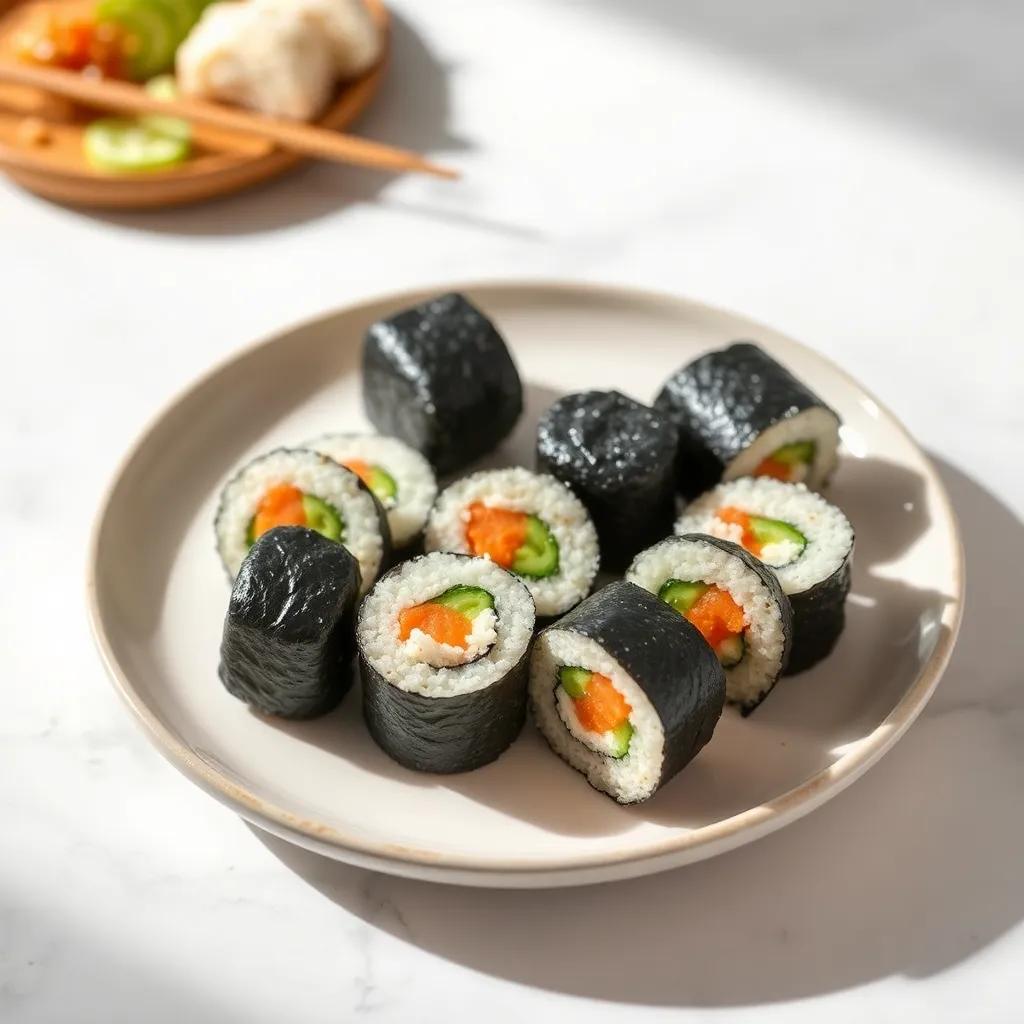
Behind the Recipe
Gimbap holds a special place in Korean food culture, tracing its roots back to a fascinating blend of history and everyday life. Inspired in part by the Japanese sushi roll, gimbap evolved into its own distinct culinary tradition during the early 20th century, adapting to Korean tastes and ingredients. The name itself—“gim” (seaweed) and “bap” (rice)—beautifully reflects the dish’s simple yet elegant composition. It quickly became a popular portable meal for workers, students, and travelers alike, thanks to its convenient size, nutritional balance, and delightful variety of textures and flavors.
For many Koreans, gimbap conjures feelings of nostalgia and family togetherness. It’s often one of the first homemade dishes children learn to help prepare, symbolizing care and home-cooked warmth. The process of layering colorful fillings and rolling them into neat cylinders is as much about ritual as it is about nourishment. Sharing gimbap at picnics, road trips, or casual gatherings brings people closer, inviting conversation and joy around a modest but meaningful meal.
In crafting these easy, vibrant, and kid-friendly gimbap rolls, this recipe honors that legacy while embracing modern kitchen convenience. By balancing authentic techniques with accessible ingredients and playful variations, it encourages cooks of all ages to connect with Korean culinary heritage in a way that’s fun, approachable, and adaptable to any lifestyle. Each roll tells a story—not just of flavor, but of cultural passage, shared memories, and the simple pleasures found in humble food made with care.
FAQ
Can I use other proteins instead of traditional beef or fish?
How far in advance can I prepare gimbap and store it?
What’s the best way to reheat gimbap without drying it out?
Can I make gimbap vegan or gluten-free?
Are there substitutions for the traditional rice used in gimbap?
How can I customize gimbap to make it more kid-friendly?
What tips do you have for rolling perfect gimbap every time?
Try It Yourself
With its bright colors, authentic flavors, and kid-friendly charm, these easy gimbap recipes bring a delightful burst of Korea straight to your kitchen. Whether you’re packing lunchboxes or sharing a fun family meal, mastering these vibrant rolls is a simple way to enjoy wholesome, hand-held goodness that everyone will love.
Give these recipes a try and let the creativity roll! We’d love to hear how your gimbap adventures turn out—drop a comment, rate the recipe, or share your own unique twist. Happy rolling!

